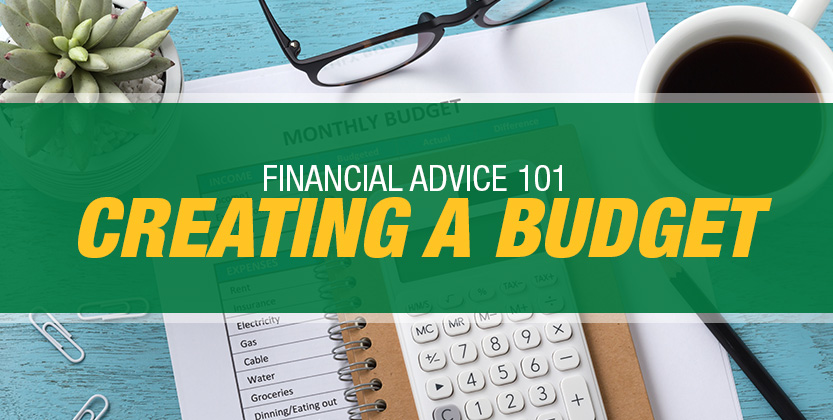
How to Create a Budget: A Step by Step Guide to Building a Budget
Though money’s coming in, it may be going right back out the door at an alarming rate. Even if someone makes a good amount of money each month, without a budget, it’s all too easy to spend too much money and end up struggling to cover credit card bills and other expenses. No matter what your income is, creating a budget can make it easier to stay on top of your finances and make sure you have money set aside in case there’s an emergency.
Steps to Creating Your Own Budget
Determine Income
Before setting a budget, determine your net income. This should be how much money is made after taxes each month. If the amount varies, use an average to determine the monthly amount. The more accurate the amount is, the easier it is to set a budget. Include other sources of income such as freelance income, interest, dividends, rental income, child support, and alimony. The key is to get a good idea of exactly how much money is coming in each month of the year.
Figure Out Monthly Expenses
Write down all of the typical expenses throughout the year. This includes monthly bills like rent and utilities. It should also include bills that are only paid once or twice per year, such as car insurance or homeowner’s insurance. Other expenses will need to be figured out as well, such as groceries, gas, clothes, and entertainment. Get a good idea of how much is spent on these each month by adding up the amounts for previous months. Also, include emergency expenses like car repairs or medical bills.
Calculate the Difference
After adding up the incomes and expenses, it’s time to see how much is spent each month. Subtract the monthly expenses from the income. The resulting number should be a positive number. If it’s a negative number, more money is being spent than is coming in, so it is necessary to look into a budget to determine where money can be saved and what can be adjusted to change this to a positive number.
What if the Number is Negative?
If the number is negative, it’s clear that trimming expenses will be needed. Eating out less frequently, buying new clothes less often, or other options can help save money and get that number positive again. If the issue is due to credit card payments or other long-term payments, there are ways to reduce these to help pay them off easier. If budgeting isn’t enough because you’re too much over budget, look into signature loans like those from King of Kash. You’ll be able to pay off these expenses, then have one lower monthly payment to worry about.
Pick Out a Budgeting Method to Use
There are a number of budgeting methods to pick from, depending on your preferences and finances. One of the most popular is the 50/30/20 budget, where 50% of the income is for needs, 30% is for wants, and 20% is for savings and debt repayment. Any budgeting method chosen should cover all needs, some wants, and savings in case of an emergency in the future. Other methods include the envelope method, activity-based, or zero-based budgeting.
Consider Using Budgeting Tools
One option many people are using today is to pick out tools that can help with budgeting. There are numerous budgeting tools available today that can make putting together a budget and sticking with it a lot easier. Spreadsheets are one option that has been used for many years now by plenty of people, but there are also apps and computer software that make it easy to budget by automatically subtracting expenses as they’re made.
Plan for Savings
A large part of budgeting is putting together a savings plan. At first, it may be a good idea to use the savings to pay off high-interest debts, as this will make it easier to save more in the future. Consolidating these debts and then paying them off can help you save more. After that, start building an emergency fund. With at least three months of expenses saved, the next step could be to start investing the savings, so it grows faster. When possible, automate savings, so you don’t have to think about it each month – the money just moves to where it needs to go.
Keep Using the Budget
Making a budget only gets you so far. Keeping up with it is what will make a difference. At the beginning of each month, write down the budget for the month and plan out how that month’s money will be spent. If your income fluctuates, the budget may change each month. If your income is steady, that will stay the same, but expenses might differ from month to month. Either way, it is important to create the budget each month to make sure it aligns with your needs. Do this every month to make it a habit and make sure you continue using the budget, so it’s possible to reach your financial goals.
Track and Revise as Needed
After the budget is written down, track progress by writing down any money that is spent and making sure no category is overspent. Once a week, review the budget to make sure you’re still on track. Then, revise the budget as needed. This may need to be done once a week if something major changes, or you may need to change it once or twice a year as your income or expenses change. The budget may need to be adjusted if your priorities change, as well. The key is to keep working with a budget, even if it does change over time.
It may be difficult to get your finances back under control, but it’s not impossible. Using a budget makes it a lot easier to get a good hold on your finances and to start working towards bringing in more money than you’re spending and being able to create savings so you won’t have to worry as much if there’s an emergency in the future. If you’re worried about debt piling up, look into how a signature loan can help you get it back under control, then start working on your budget to keep it that way.
Cary Silverman is a consummate entrepreneur having sold multiple companies during his 20 years of business experience in the financial industry, but for him, it isn’t about the money. His success is rooted in his passion to focus on doing something better today than it was done yesterday. These days, he’s the CEO of Waldo General, Inc. that oversees the operation of King of Kash.

